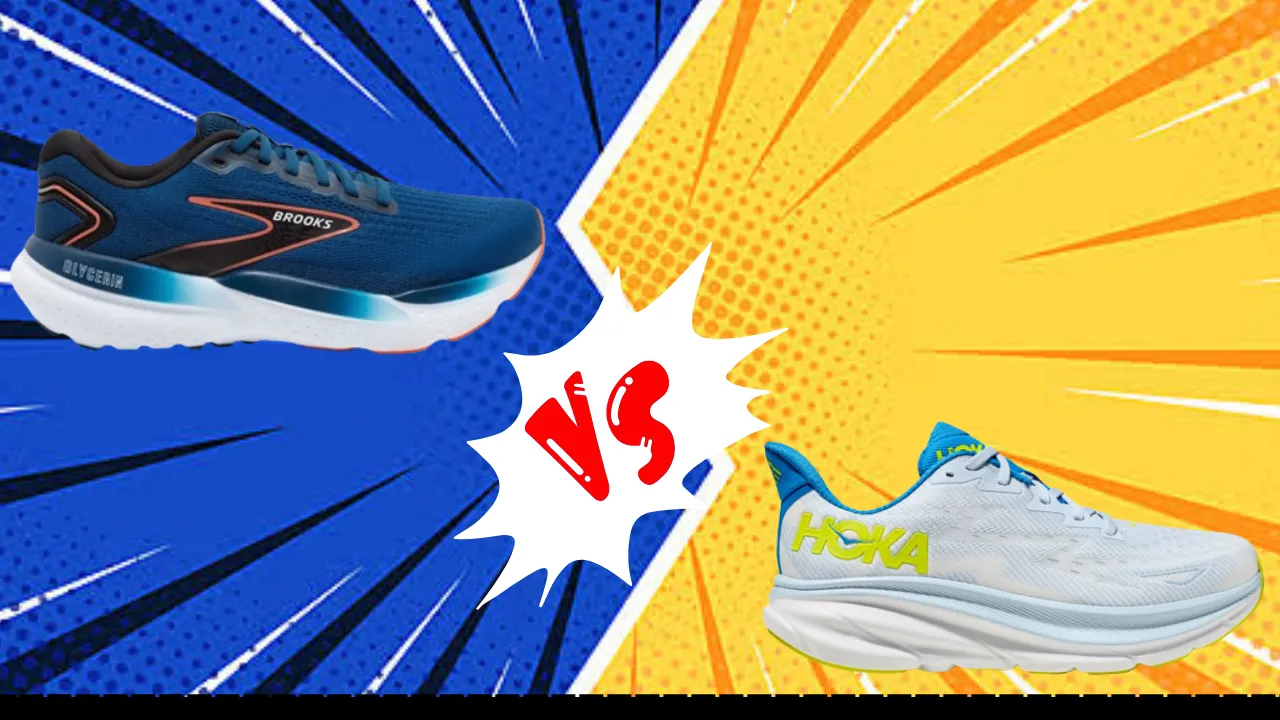Finding the right running shoe is crucial for comfort, performance, and injury prevention. Two popular neutral cushioned shoes are the Brooks Glycerin 21 and Hoka Clifton 9.
But how do you choose between these two comfortable trainers? This in-depth comparison highlights the key differences so you can decide which is best for you.
Similarities And Differences Between Brooks Glycerin 21 And Hoka Clifton 9:
| Feature | Brooks Glycerin 21 | Hoka Clifton 9 |
|---|---|---|
| Launched In | 2024 | 2023 |
| Stability | Supportive and stable ride | Neutral |
| Flexibility | Moderately flexible | Flexible |
| Sizing | Men’s 7-15, 17 / Women’s 5-12 | True to size |
| Weight | 9.30-10.50 oz | 9.5 oz (men’s), 8.8 oz (women’s) |
| Cushion | Plush, comfortable | Soft, responsive |
| Outsole | Durable rubber | Rubber with meta-rocker design |
| Midsole | DNA Loft | Compressed EVA foam |
| Upper | Engineered mesh | Engineered mesh |
| Retail Price | $160 | $145 |
Features Comparison:
Materials:
The Glycerin 21 uses a durable rubber outsole, a DNA Loft cushioned midsole, and an engineered mesh upper. The mesh upper provides a secure, breathable fit.
The full-length DNA Loft midsole gives a plush, comfortable underfoot feel. It is softer than previous DNA Loft versions for a more “slipper-like” feel. The rubber outsole is durable enough for miles of wear.


The Clifton 9 has a lightweight compressed EVA foam midsole encased in a durable rubber outsole with Hoka’s early stage meta-rocker design. The engineered mesh upper offers a comfortable, breathable fit. Overall, the materials provide a soft, responsive, and smooth ride. However, some find the EVA foam lacks longevity compared to DNA Loft.
Durability:
The Glycerin 21 is known for its durability, thanks to the full rubber outsole and DNA Loft midsole which maintains cushioning for longer. The outsole rubber provides grip and abrasion resistance for many miles of use.
The engineered mesh upper also remains intact even after heavy mileage. Many runners get over 500 miles out of their Glycerins before considering replacement.
The Clifton 9 has decent durability but doesn’t tend to last as long as the Glycerin. The EVA foam compresses permanently over time so the cushioning deteriorates faster than DNA Loft.
However, the rubber outsole holds up well against wear and tear. The upper also remains intact for many miles. Overall, the Clifton 9 should hold up for 300-400 miles for most runners before replacing them. So the Glycerin wins for long term durability.
Fit:
The Glycerin 21 runs true to size for most runners. The engineered mesh upper provides a comfortable, secure midfoot wrap while allowing some room for toe splaying. The plush collar and tongue cushioning prevent any heel slippage or hot spots. However, some note the forefoot is on the narrower side.


The Clifton 9 also runs true to size but has a more accommodating toe box with its foot-shaped design. This allows more room for natural toe splay while on the run. However, the midfoot and heel are on the narrower side. Some runners with wider feet find their toes brushing against the edge of the shoe at times. The low heel collar can also cause some heel slipping issues.
Overall, the Glycerin 21 might be a better choice for narrow-footed runners who want a secure midfoot lockdown. The Clifton 9 suits runners wanting a more foot-shaped, roomy toe box design.
Stability:
The Glycerin 21 offers a very stable, supportive ride thanks to the full-length DNA Loft midsole which gently cradles the foot on impact. The durable rubber outsole also provides a wide, stable base with solid traction.
The upper holds the foot securely in place without any sliding. This makes the Glycerin a good choice for moderate overpronators who need a bit more stability in a neutral shoe.
The Clifton 9 has a soft, somewhat unstable ride due to the compressible foam midsole. The low drop and curved shape allow for a very smooth heel to toe transition but doesn’t provide much guidance or support.
It lacks medial support features as well. As a result, severe overpronators may find their ankles rolling inward excessively in the shoe. However, neutral runners enjoy the soft, natural ride.
For those needing more stability and support, the Glycerin 21 is the better pick. But neutral runners who don’t require much structure can enjoy the soft, free ride of the Clifton 9.
Cushioning:
Runners praise the Glycerin 21’s plush DNA Loft cushioning which provides softness without losing responsiveness or durability. The full-length midsole delivers a “marshmallow-y” soft feel underfoot, absorbing impact nicely without feeling mushy.
However, it doesn’t provide as much “bounce back” energy return as some foams. Also, the 10mm drop places more cushioning under the heel so forefoot strikers may find it too soft in that area.
The Clifton 9 delivers a very soft, responsive cushion thanks to the compressed EVA foam midsole. Many runners describe the ride as “pillowy,” providing plenty of protection even over long distances.
The 5mm drop distributes cushioning more evenly from heel to toe as well, accommodating different foot strike patterns. However, the soft foam compresses fully during impact so heavier runners may bottom out.
Overall, the Glycerin offers plush, even cushioning while the Clifton provides a softer, bouncier ride. Go with the Glycerin 21 for those wanting stable, durable cushioning and the Clifton 9 for a responsive, well-cushioned feel.
Value:
At the $160 retail price, the Glycerin 21 costs slightly more than the Clifton 9 which has an MSRP of $145. However, fans of the Glycerin praise its durability and consistent performance over many miles, making it well worth the higher price. Runners tend to hold onto their Glycerins for several years and multiple iterations of new models because the shoe ages so well.
The Clifton 9 still provides good value for its price point. The soft, responsive ride makes it a comfortable choice for daily training and long runs. However, some find the foam loses its bounce quickly compared to shoes like the Glycerin. Still, runners who prefer a softer, more flexible and foot-shaped feel get great value from the Clifton.
Overall, the Glycerin is the better value for runners happy to pay a little more up front for a durable shoe that maintains its cushioning and support over the long haul. But budget-minded runners still get solid performance from the Clifton line.
Performance Comparison:
Walking:
The Glycerin 21 provides a very comfortable walking shoe with its plush cushioning and stable support. The roomy forefoot allows natural toe splay to push off fully with each step. And the soft midsole absorbs impact gently on the joints. However, some may find it a little heavy for all-day wear.
The Clifton 9 is quite comfortable for walking as well. The responsive foam provides good shock absorption and energy return with a natural gait. And the breathable upper keeps feet cool and dry for long walks. The only downside is the narrow heel and midfoot may rub or pinch some wearers after prolonged use.
Running:
For running, the Glycerin 21 offers a smooth, stable ride over any distance. There’s plenty of durable cushioning to soften impact while also providing solid support. The grippy outsole also gives good traction. However, the somewhat bulky design may feel less responsive for faster paces.
The Clifton 9 provides a very soft, low-to-the-ground running feel. The responsive foam and smooth transition encourage a natural running gait at easy paces but can feel less stable at faster speeds.
The flexible design allows plenty of freedom of movement through the stride. However, narrow feet may get the best fit here. Wider-footed runners may experience some irritation from the snug upper.
So Glycerin is preferable for high mileage, with its blend of cushioning and support. But the Clifton offers a more natural, flexible ride for easy efforts. Race day and tempo runners are better off looking at shoes beyond these two models.
Plantar Fasciitis:
The Glycerin 21’s plush cushioning does an excellent job of softening impact to prevent further aggravation of plantar fasciitis. The ample midsole absorbs shock evenly throughout the footstrike. The stability features also prevent overpronation which can exacerbate heel and arch pain.
The Clifton 9 also provides good cushioning from heel strikes thanks to the soft foam. However, some find it doesn’t offer enough midfoot support which plantar fasciitis sufferers often need. The narrow heel and midfoot areas may also rub and irritate the arch over time.
So for plantar fasciitis specifically, Glycerin 21 is likely the better choice between the two.
Standing All Day:
For those on their feet all day, the Glycerin 21 offers superior comfort and support. The plush DNA Loft midsole cushions and cradles the foot all shift long without packing down. And the roomy toe box prevents pinching or irritation even after hours of standing.
The Clifton 9 isn’t quite as well suited for all-day wear. The soft foam underfoot tends to compress more permanently after prolonged standing which reduces comfort over time. And the snugger fit may rub or pinch some feet around the toes or heels while standing for long stretches.
Final Verdict:
Overall, the Brooks Glycerin 21 and Hoka Clifton 9 are both comfortable neutral trainers but each excels in different areas. The Glycerin’s durable cushioning, supportive ride, and versatile fit make it the better choice for high mileage training and runners who need some extra stability. The plush midsole also provides superior comfort for long distances and all-day wear.
In contrast, the Clifton 9 shines when you want a soft, natural running experience. The pillowy ride encourages your natural gait while still providing responsive cushioning.
However, the narrow fit and lack of structure don’t work as well for overpronators or wide-footed runners. And the foam may deteriorate faster than the Glycerin’s.
So while both are cushioned daily trainers, the Glycerin 21 suits more foot types and is the more durable option. But runners wanting a super soft, flexible feel will prefer the unique ride of the Clifton 9. Try both models to determine which best matches your preferences and needs.

